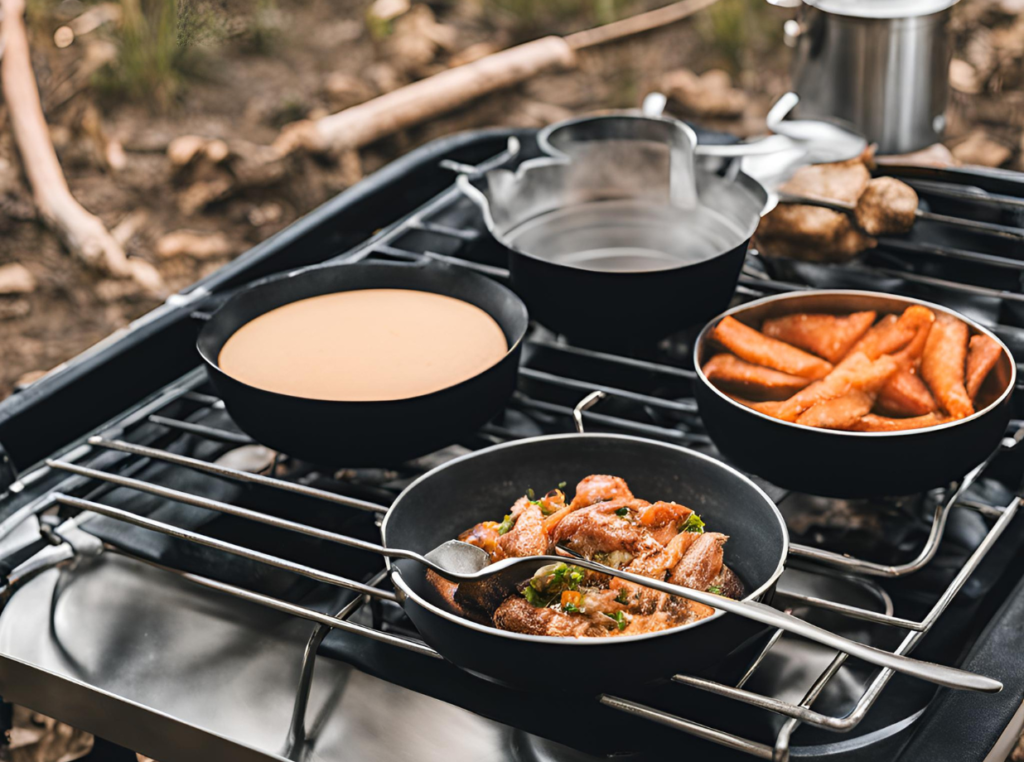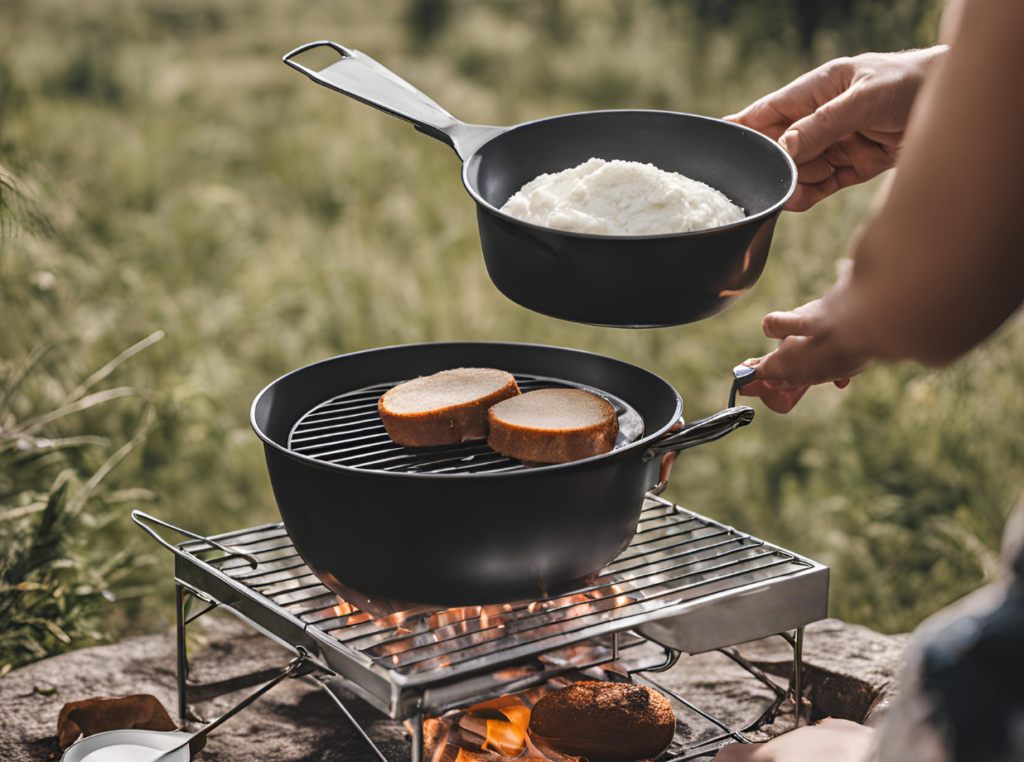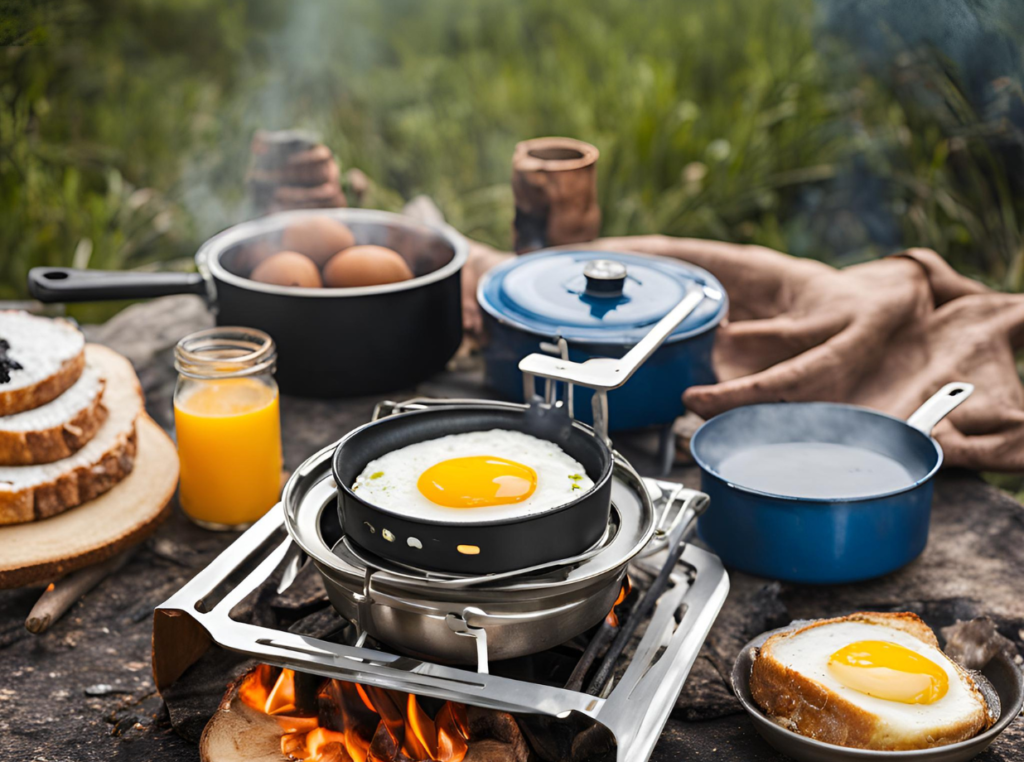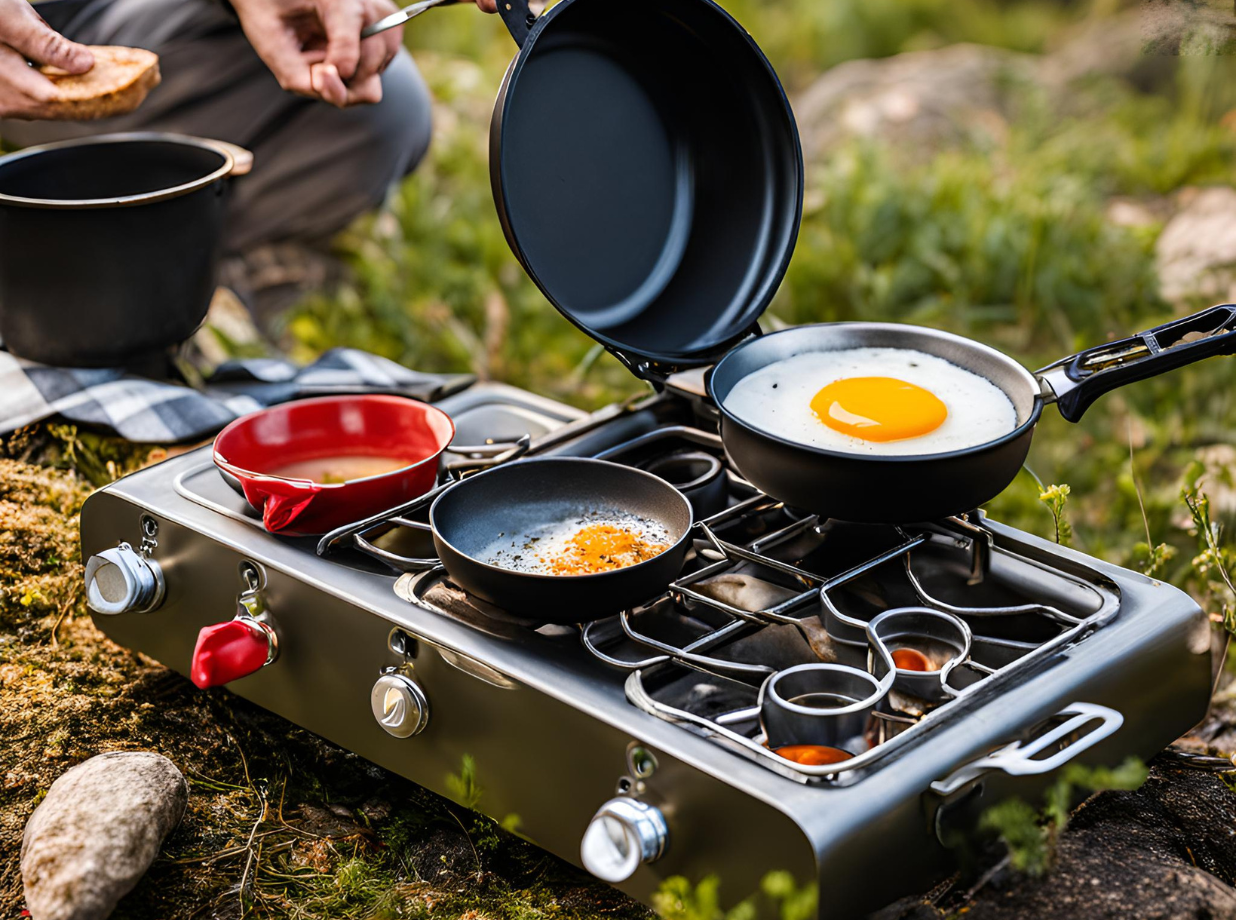Outdoor cooking is an art that combines the call of the wild with the joy of preparing a delicious meal under the open sky. Whether you’re a seasoned camper or an adventurous foodie, taking your outdoor cooking to the next level can transform your camping experience. Imagine savoring a perfectly grilled steak, freshly baked bread, or a gourmet breakfast—all cooked over a portable stove amidst nature’s beauty. This guide dives deep into advanced tips and techniques designed to elevate your outdoor culinary skills, ensuring every meal is a memorable one.
“The simplest things can bring the most happiness.” – Izabella Scorupco
- Enhance your fuel efficiency: Learn the best practices to make your fuel last longer.
- Master heat control: Techniques for achieving perfect temperature regulation.
- Engage with advanced grilling methods: Take your grilling prowess up a notch with expert tips.
- Get creative with campfire baking: From breads to desserts, discover the joys of baking in the wild.
Choosing the Right Camping Stove for Advanced Techniques

When delving into advanced cooking techniques outdoors, picking the right camping stove is crucial. Factors such as fuel type, portability, and burner configuration play a significant role in enhancing your culinary adventures. Let’s break these down:
Fuel Types
The type of fuel your stove uses can greatly affect your cooking experience. Propane stoves are popular due to their ease of use and consistent performance in various weather conditions. However, they can be bulky. On the other hand, liquid fuel stoves are less convenient but more efficient in cold climates and at high altitudes. For the environmentally conscious, biofuel stoves can be a fantastic choice as they use natural materials like twigs and pinecones.
Portability and Weight
Weight becomes a critical factor when you’re carrying your stove for any distance. For backpackers, lightweight canister stoves are ideal due to their compact size and minimal weight. If your adventure is more stationary, perhaps at a basecamp, you might prioritize a stove’s cooking capabilities over its weight, going for something more robust like a dual-burner.
Burner Configuration
Single-burner stoves are great for simple meals, but for those who want to elevate their outdoor cooking, a multi-burner stove offers much more versatility. Imagine whipping up a gourmet meal with a sturdy two-burner stove: boiling water for pasta on one side while frying up a delicious sauce on the other. Additionally, look for stoves that allow for simmer control, giving you the ability to cook more delicately rather than always at full blast.
Consider your specific needs and the type of cooking you plan to do. Will you be simmering soups, searing steaks, or baking bread? The right camping stove tailored to your preferences can turn an ordinary camping trip into a culinary adventure.
Essential Gear for Expert Campfire Chefs
One of the keys to mastering advanced outdoor cooking techniques is having the right gear. Here are some must-have items for your portable stove setup:
- High-Quality Cookware: Invest in durable cookware that can withstand open flames and high heat. Cast iron pans and stainless steel pots are popular choices for their durability and heat retention.
- Precision Thermometer: A reliable thermometer is essential for ensuring your meats and other foods are cooked to perfection. Instant-read digital thermometers are particularly handy.
- Sharp Knives: A set of sharp, high-quality knives will make food preparation much easier and safer. Consider including a chef’s knife, paring knife, and a serrated knife in your kit.
- Grill Grate: Adding a grill grate to your setup allows for versatile cooking options. You can grill meats directly over the flame or use it as a makeshift toaster for bread.
- Windscreen: Outdoor conditions can be unpredictable. A windscreen helps stabilize the flame and improve fuel efficiency during windy conditions, ensuring an even cook.
- Heavy-duty Tongs and Spatula: These essential tools make it easier to flip and handle food on the stove or grill. Look for options with long handles to keep your hands safely away from the heat.
- Heat-resistant Gloves: Protect your hands from burns and make it easier to handle hot cookware with a good pair of heat-resistant gloves.
- Foldable Table: Having a sturdy, portable table provides a convenient workspace and keeps your cooking area organized.
- Seasoning Kit: Pre-pack a small kit with your favorite herbs, spices, and oils. This ensures you never have to compromise on flavor, even when you’re miles away from your kitchen.
By assembling a well-equipped cooking kit, you’ll be prepared for any culinary challenge the great outdoors throws at you. With these tools in hand, you’re ready to elevate your campfire cooking to a gourmet level.
Prepping Ingredients for Outdoor Gourmet Meals
Preparation is the cornerstone of culinary success, especially when cooking outdoors. Begin with a detailed meal plan. Know what you want to cook and break down the necessary ingredients. This helps minimize the load you carry and ensures you have everything you need.
Pre-Chop Ingredients: Whenever possible, chop, slice, and dice ingredients at home. Store them in airtight containers or zip-lock bags. Not only does this save you time at the campsite, but it also reduces the amount of utensils you need to bring.
Marinate in Advance: Marinading meats and vegetables ahead of time not only enhances flavor but also ensures that you can quickly throw them on the stove without additional prep work. Use resealable bags for marinating; they save space and are easy to pack.
Measure and Pack Spices: Instead of bringing your entire spice rack, pre-measure the required amounts for each recipe and store them in small, labeled jars or resealable bags. This keeps you organized and prevents any seasoning mishaps.
Use Minimalistic Containers: Invest in a set of lightweight, collapsible containers. They’re perfect for packing everything from chopped veggies to pre-made sauces and take up little space once empty.
Ensuring your ingredients are well-prepped not only streamlines your cooking process but significantly enhances your overall outdoor cooking experience. Proper preparation is your ticket to gourmet success in the wild!
Mastering Heat Control with Your Camping Stove

Heat control is paramount when it comes to achieving perfectly cooked meals in the great outdoors. One advanced technique is zone cooking. This involves dividing your cooking area into different heat zones: a high-heat zone for searing and boiling, and a low-heat zone for simmering or keeping food warm.
To create effective heat zones with your camping stove, start by arranging your burners strategically. If your stove has dual burners, you can set one to high heat and the other to low. For single-burner stoves, you can adjust the flame size or use a heat diffuser to distribute heat more evenly.
Pro Tip: Always preheat your cookware before placing food on it. This helps in getting an even sear and ensures that your ingredients cook uniformly. Cast iron or heavy-bottomed pans retain heat well and are perfect for this purpose.
Another critical aspect of heat control is wind management. Wind can drastically affect your stove’s performance. Use a windscreen to protect the flame and maintain consistent heat. Some camping stoves come with built-in windscreens, but if yours doesn’t, consider investing in a portable one.
Finally, don’t underestimate the value of practice. Familiarize yourself with how your portable stove responds to various conditions. Experiment with different settings and cooking techniques during shorter trips before embarking on longer adventures. This way, you’ll better understand how to manipulate heat to your advantage, making your outdoor cooking experience both enjoyable and successful.
Advanced Grilling Techniques on a Portable Stove
Grilling on a portable stove can go far beyond the basics of burgers and hotdogs. With the right techniques, you can elevate your outdoor cooking game to a whole new level. Let’s dive into some advanced grilling tactics.
Reverse Searing
Reverse searing is an excellent method for cooking thicker cuts of meat to perfection. Start by cooking your meat on low heat until it’s just below your desired doneness. Then, sear it over high heat for a crispy, flavorful crust. This technique ensures that your meat is juicy and evenly cooked.
Using a Cast Iron Skillet
A cast iron skillet is a versatile tool that works wonderfully on a portable stove. It distributes heat evenly and can handle high temperatures. Sear meats, sauté vegetables, or even bake cornbread directly on your portable stove to add a rustic touch to your outdoor meals.
Wood Smoke Enhancement
Infuse your food with the rich flavors of wood smoke, even without a traditional grill. Use wood chips wrapped in foil with holes poked through or place a small smoker box on your portable stove. This infusion technique brings an authentic smoky taste to your grilled dishes.
Zone Grilling
Create cooking zones on your portable stove by arranging coals or burners at different heat levels. This method allows you to sear, cook through, and keep food warm all at once. Managing multiple temperature zones enhances your control and prevents overcooking.
Plank Grilling
Grilling on a wooden plank, such as cedar or maple, imparts a subtle, aromatic flavor to your food. Soak the plank in water for at least an hour, then place it on your grill. Add your meat or vegetables on top of the plank, close the lid, and let the wood’s essence infuse your dish.
Creating Restaurant-Quality Meals in the Wild
To craft restaurant-quality meals while camping, you’ll need to combine preparation, technique, and a dash of culinary creativity. It starts with selecting fresh, high-quality ingredients that can hold up well during your trip. Consider pre-marinating meats and pre-chopping vegetables for easier handling on-site. Think about durable produce like bell peppers, onions, and carrots that travel well.
Marination and Flavor Infusion
Infusing flavor into your dishes pre-trip can make a world of difference. Marinate proteins in resealable bags or vacuum-sealed pouches. This not only saves space but ensures flavors meld deeply into the meat. Try robust marinades with herbs, citrus, garlic, or even a touch of honey or soy for complexity.
Using Herbs and Spices
Don’t skimp on the aromatic herbs and spices. These can turn a simple dish into gourmet fare. Pack a variety of dried herbs and spice mixes in compact containers. Fresh herbs like rosemary, thyme, and parsley can also be wrapped in damp paper towels and stored in zip-lock bags to maintain freshness.
Elevating Your Sides
A restaurant-quality meal is more than just a main dish—it’s also about the sides. Get creative by transforming basic ingredients. Grilled corn on the cob, seasoned couscous, and roasted potatoes can be made easily using your portable stove. Don’t forget about sauces and garnishes. A quick chimichurri or a lemon zest garnish can elevate your meal effortlessly.
Plating and Presentation
Even in the wild, presentation matters. Use nature’s tableware—a large, clean leaf or a rustic wooden plate can add authentic charm. Arrange your food thoughtfully, considering color and texture combinations. An aesthetically pleasing meal tastes better and adds to the overall outdoor dining experience.
Lastly, remember to enjoy the process. Cooking in the wild offers a unique opportunity to connect with nature while indulging in the joy of preparing and sharing food. With some foresight and creativity, your campsite dinners will be the highlight of your outdoor adventures.
Perfecting the Art of Campfire Baking
Imagine the satisfaction of biting into a fresh, warm pastry or bread roll while surrounded by the beauty of the great outdoors. Campfire baking may sound daunting, but with a few advanced tips, it can become one of the highlights of your outdoor cooking experience.
Choosing the Right Bakeware
Opt for sturdy, heat-resistant materials. Cast iron is a favorite among outdoor chefs thanks to its ability to evenly distribute heat and withstand direct flames. Using a Dutch oven or cast iron skillet will give you consistent results, much like your oven at home.
Mastering Heat Management
For successful campfire baking, controlling the temperature is crucial. Start by creating a good bed of coals. Arrange the coals evenly around your cookware, understanding that baking typically requires lower, even heat. Covering your Dutch oven with coals on top will mimic the even heat distribution of a traditional oven.
Baking with Reflector Ovens
Reflector ovens are portable and specifically designed for campfire use. They reflect the heat onto your bakeware and can be placed alongside your campfire. They are particularly good for baking biscuits, cookies, and even small cakes. Setting them up just right can turn your campfire into a gourmet bakery.
Using Foil Packs
For a simpler approach, aluminum foil packs can be a wonderful addition to your campfire baking repertoire. Prepare your dough or batter, wrap it securely in foil, and place it among the coals. This method works wonders for quick breads and desserts like chocolate bananas or apple crisps.
Monitoring Progress
Baking outdoors requires a bit more attention than indoor baking. Periodically check your baked goods for doneness to avoid burning. Test breads and cakes with a toothpick, and make sure top and bottom are cooked evenly.
Elevating Your Breakfast Game Outdoors

There’s something truly magical about starting your day in the great outdoors with a warm, hearty meal. Elevating your breakfast game while camping isn’t just about sustenance; it’s about adding that extra touch of gourmet flair to your morning routine.
Plan Your Menu: Before you head out, think about the kind of breakfast you want to create. Opt for versatile ingredients like eggs, cheese, fresh herbs, and various proteins that can be easily combined and cooked on a portable stove. A little planning goes a long way in transforming basic ingredients into an outdoor feast.
Pancakes and Waffles: Bringing pre-made pancake or waffle mix can simplify your morning. Consider packing a small non-stick griddle or a waffle iron designed for camping. Adding fresh berries or nuts can enhance flavor and lend an extra touch of luxury.
Coffee and Beverages: Don’t forget about your morning brew. A portable French press or a pour-over coffee setup can make all the difference. For an added touch, bring along spices like cinnamon or nutmeg to sprinkle on top.
Breakfast Skillets: Utilizing a cast iron skillet, create hearty breakfast scrambles by combining eggs, chopped vegetables, and your favorite breakfast meats. Consider pre-chopping ingredients at home to save time at your campsite.
Oatmeal Innovations: Instant oatmeal is a camping staple, but you can elevate it by adding dried fruits, nuts, honey, or even a swirl of peanut butter. Preparing your own blend of gourmet toppings in advance can turn a simple meal into a treat.
Summary
Embracing the world of outdoor cooking with a portable stove can transform your camping experience into a gourmet adventure. From selecting the ideal stove that fits your specific needs to mastering sophisticated grilling techniques, this guide has equipped you with the knowledge to elevate every meal in nature. By understanding the nuances of different fuel types, optimizing heat control, and experimenting with advanced methods like reverse searing and plank grilling, you’re well on your way to becoming an expert camp chef.
We’ve explored how essential gear, like quality bakeware and cast iron skillets, can make a significant difference in your cooking outcomes. Prepping ingredients meticulously and mastering heat management are crucial steps that contribute to your success. Techniques such as using foil packs for baking and incorporating wood smoke for added flavor ensure that each dish you create is not only delicious but also memorable.
Breakfast, often considered the most important meal of the day, can also be a highlight of your outdoor culinary repertoire. By enhancing your breakfast game, you start your day off with satisfying, hearty meals that fuel your adventures. In essence, with the right tools, preparation, and techniques, you can replicate the comfort and quality of restaurant meals while embracing the rustic charm of outdoor living.
As you continue to hone your skills, remember that the beauty of outdoor cooking lies in experimentation and enjoyment. Each meal is an opportunity to test new ideas and savor the experience. Happy cooking, and may your next outdoor meal be your best one yet!



